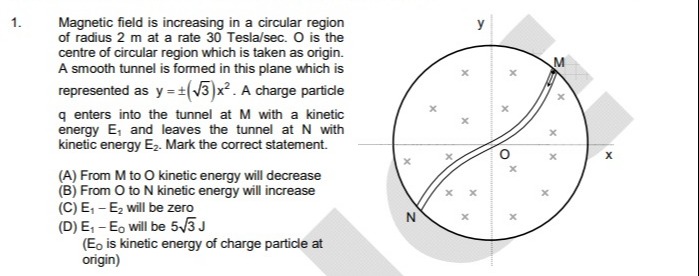Question
Question: Magnetic field is increasing in a circular region of radius 2 m at a rate 30 Tesla/sec. O is the cen...
Magnetic field is increasing in a circular region of radius 2 m at a rate 30 Tesla/sec. O is the centre of circular region which is taken as origin. A smooth tunnel is formed in this plane which is represented as y=±(3)x2. A charge particle q enters into the tunnel at M with a kinetic energy E1 and leaves the tunnel at N with kinetic energy E2. Mark the correct statement.

From M to O kinetic energy will decrease
From O to N kinetic energy will increase
E1−E2 will be zero
E1−E0 will be 53 J (E0 is kinetic energy of charge particle at origin)
C
Solution
The magnetic field is increasing in a circular region of radius 2 m at a rate dB/dt=30T/s. The induced electric field at a distance r from the center is given by E=21rdtdB. The direction of the induced electric field is tangential and counter-clockwise. In Cartesian coordinates, E=21dtdB(−y,x)=15(−y,x).
The tunnel is represented by y=±3x2. The particle enters at M and leaves at N. The tunnel intersects the circle x2+y2=22=4. For the upper branch y=3x2, x2+(3x2)2=4⟹x2+3x4=4⟹3x4+x2−4=0. Let u=x2, then 3u2+u−4=0⟹(3u+4)(u−1)=0. Since u=x2≥0, u=1, so x2=1, x=±1. For x=1, y=3(1)2=3. So M is at (1,3). For x=−1, y=3(−1)2=3. This point is not N. For the lower branch y=−3x2, x2+(−3x2)2=4⟹3x4+x2−4=0, so x2=1, x=±1. For x=−1, y=−3(−1)2=−3. So N is at (−1,−3). The tunnel passes through the origin O (0,0).
The change in kinetic energy of the charged particle is equal to the work done by the electric field: ΔK=WE=q∫E⋅dl. WE=q∫15(−ydx+xdy).
From M to O, the path is y=3x2, dy=23xdx. The integration is from (1,3) to (0,0), i.e., from x=1 to x=0. WM→O=15q∫x=10(−3x2dx+x(23xdx))=15q∫103x2dx=15q3[3x3]10=15q3(0−31)=−53q. The change in kinetic energy from M to O is E0−E1=WM→O=−53q. So E1−E0=53q.
From O to N, the path is y=−3x2, dy=−23xdx. The integration is from (0,0) to (−1,−3), i.e., from x=0 to x=−1. WO→N=15q∫x=0−1(−(−3x2)dx+x(−23xdx))=15q∫0−1(3x2−23x2)dx=15q∫0−1(−3x2)dx=−15q3[3x3]0−1=−15q3(3(−1)3−0)=−15q3(−31)=53q. The change in kinetic energy from O to N is E2−E0=WO→N=53q.
The total change in kinetic energy from M to N is E2−E1=WM→N=WM→O+WO→N=−53q+53q=0. So, E1−E2=0.
Let's evaluate the options:
(A) From M to O kinetic energy will decrease. E0−E1=−53q. If q>0, E0<E1, so kinetic energy decreases. If q<0, E0>E1, so kinetic energy increases. This statement is not always true.
(B) From O to N kinetic energy will increase. E2−E0=53q. If q>0, E2>E0, so kinetic energy increases. If q<0, E2<E0, so kinetic energy decreases. This statement is not always true.
(C) E1−E2 will be zero. This is true as calculated above.
(D) E1−E0 will be 53 J. We found E1−E0=53q. This statement is true only if q=1 C. Since the charge q is not given to be 1 C, this statement is not necessarily true.
Therefore, the only correct statement is (C).
